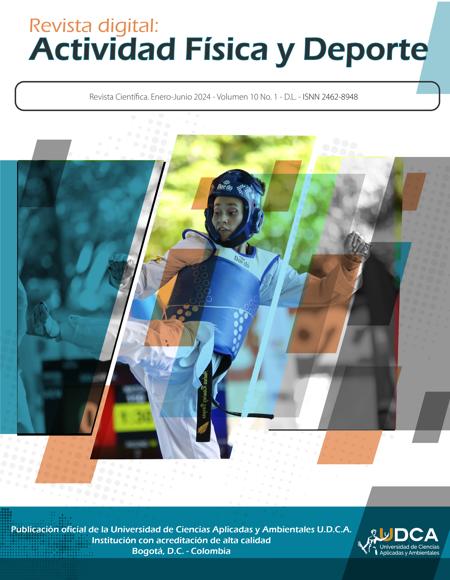Método de entrenamiento híbrido complejo para desarrollar fuerza máxima y potencia muscular aplicado al karate. Un estudio de caso
Complex hybrid training method to develop maximum strength and muscle power applied to karate. A case study
Contenido principal del artículo
Resumen
Introducción: el karate es un deporte de combate caracterizado por altas demandas de producción de potencia muscular; no obstante, para lograrlo es necesario tener altos niveles de fuerza máxima, como capacidad física primordial. Objetivo: proponer un nuevo método de entrenamiento denominado método de entrenamiento hibrido complejo (MEHC) y determinar sus efectos sobre la fuerza máxima y potencia muscular en la disciplina de karate. Materiales y métodos: participó un atleta de karate (México), seleccionado nacional, clasificado a Juegos Panamericanos 2023. Se aplicó el MEHC durante la etapa de fuerza máxima y transformación a potencia muscular. Se realizaron pruebas para medir potencia muscular, mediante velocidad de ejecución en miembros inferiores (squat jump) y superiores (bench press throw); la fuerza máxima se evaluó de igual manera (velocidad de ejecución) en sentadilla y bench press. Resultados y discusión: la potencia muscular aumentó 0,6 % en el squat jump (1,62 m/s pre y 1,63 m/s post) y el bench press throw mejoró 2,5 % (0,79 m/s pre y 0,81 m/s post). La fuerza máxima incrementó del 12,5 % en sentadilla (120 kg a 0,27 m/s pre y 135 kg a 0,28 m/s post), mientras que en bench press mejoró 4,4% (85 kg a 0,13m/s pre y 90 kg a 0,15m/s post). Conclusiones: los hallazgos de la presente investigación sugieren que el MEHC mejora los niveles de fuerza máxima y potencia muscular en un atleta de karate de alto nivel.
Palabras clave:
Descargas
Datos de publicación
Perfil evaluadores/as N/D
Declaraciones de autoría
- Sociedad académica
- Universidad de Ciencias Aplicadas UDCA
- Editorial
- Universidad de Ciencias Aplicadas y Ambientales U.D.C.A
Detalles del artículo
Referencias (VER)
ASOCIACIÓN MÉDICA MUNDIAL, AMM. 1975. Declaración de Helsinki. Principios éticos para las investigaciones médicas en seres humanos. Tokio-Japón: Asociación Médica Mundial.
BALSALOBRE-FERNÁNDEZ, C.; TORRES-RONDA, L. 2021. The implementation of velocity-based training paradigm for team sports: framework, technologies, practical recommendations and challenges. Sports. 9(4):47. https://doi.org/10.3390/sports9040047 DOI: https://doi.org/10.3390/sports9040047
BENEKE, R.; BEYER, T.; JACHNER, C.; ERASMUS, J.; HÜTLER, M. 2004. Energetics of karate kumite. European Journal of Applied Physiology. 92:518-523. https://doi.org/10.1007/s00421-004-1073-x DOI: https://doi.org/10.1007/s00421-004-1073-x
BOGDANIS, G.C.; TSOUKOS, A.; BROWN, L.E.; SELIMA, E.; VELIGEKAS, P.; SPENGOS, K.; TERZIS, G. 2018. Muscle fiber and performance changes after fast eccentric complex training. Medicine & Science in Sports & Exercise. 50(4):729-738. https://doi.org/10.1249/mss.0000000000001507 DOI: https://doi.org/10.1249/MSS.0000000000001507
BOGDANIS, G.C.; TSOUKOS, A.; KALOHERI, O.; TERZIS, G.; VELIGEKAS, P.; BROWN, L.E. 2019. Comparison between unilateral and bilateral plyometric training on single-and double-leg jumping performance and strength. The Journal of Strength & Conditioning Research. 33(3):633-640. https://doi.org/10.1519/jsc.0000000000001962 DOI: https://doi.org/10.1519/JSC.0000000000001962
BOMPA, T.O. 1996. Variations of periodization of strength. Strength and Conditioning Journal. 18(3):58-61. DOI: https://doi.org/10.1519/1073-6840(1996)018<0058:VOPOS>2.3.CO;2
CAMACHO VELÁZQUEZ, J.E.; OCHOA REYES, N.D.; RINCÓN BOLÍVAR, N.J. 2019. Revisión teórica de la planificación tradicional y contemporánea en el entrenamiento deportivo. Revista. Actividad física y deporte. 5(2):171-181 https://doi.org/10.31910/rdafd.v5.n2.2019.1265 DOI: https://doi.org/10.31910/rdafd.v5.n2.2019.1265
CHAABÈNE, H.; FRANCHINI, E.; STERKOWICZ, S.; TABBEN, M.; HACHANA, Y.; CHAMARI, K. 2015. Physiological responses to karate specific activities. Science & Sports. 30(4):179-187. https://doi.org/10.1016/j.scispo.2015.03.002 DOI: https://doi.org/10.1016/j.scispo.2015.03.002
COOK, C.J.; BEAVEN, C.M.; KILDUFF, L.P. 2013. Three weeks of eccentric training combined with overspeed exercises enhances power and running speed performance gains in trained athletes. Journal of Strength and Conditioning Research. 27(5):1280-1286. https://doi.org/10.1519/JSC.0b013e3182679278 DOI: https://doi.org/10.1519/JSC.0b013e3182679278
DORIA, C.; VEICSTEINAS, A.; LIMONTA, E.; MAGGIONI, M.A.; ASCHIERI, P.; EUSEBI, F.; PIETRANGELO, T. 2009. Energetics of karate (kata and kumite techniques) in top-level athletes. European Journal of Applied Physiology. 107(5):603-610. https://doi.org/10.1007/s00421-009-1154-y DOI: https://doi.org/10.1007/s00421-009-1154-y
GOŁAS, A.; MASZCZYK, A.; ZAJAC, A.; MIKOŁAJEC, K.; STASTNY, P. 2016. Optimizing post activation potentiation for explosive activities in competitive sports. Journal of Human Kinetics. 52:95-106. https://doi.org/10.1515/hukin-2015-0197 DOI: https://doi.org/10.1515/hukin-2015-0197
GONZÁLEZ-BADILLO, J.J.; MARQUES, M.C.; SÁNCHEZ-MEDINA, L. 2011. The importance of movement velocity as a measure to control resistance training intensity. Journal of human kinetics. 29:15-19. https://doi.org/10.2478/v10078-011-0053-6 DOI: https://doi.org/10.2478/v10078-011-0053-6
HAFF, G.G.; NIMPHIUS, S. 2012. Training principles for power. Strength and Conditioning Journal. 34(6):2-12. https://doi.org/10.1519/SSC.0b013e31826db467 DOI: https://doi.org/10.1519/SSC.0b013e31826db467
LOTURCO, I.; NAKAMURA, F.Y.; LOPES-SILVA, J.P.; SILVA-SANTOS, J.F.; PEREIRA, L.A.; FRANCHINI, E. 2016. Physical and physiological traits of a double world karate champion and responses to a simulated kumite bout: A case study. International Journal of Sports Science & Coaching. 12(1):138-147. https://doi.org/10.1177/1747954116684395 DOI: https://doi.org/10.1177/1747954116684395
MAGNANI BRANCO, B.H.; FRANCHINI, E. 2021. Developing maximal strength for combat sports athletes. Revista de Artes Marciales Asiáticas. 16(1):86-132. https://doi.org/10.18002/rama.v16i1s.7002 DOI: https://doi.org/10.18002/rama.v16i1s.7002
MARGARITOPOULOS, S.; THEODOROU, A.; METHENITIS, S.; ZARAS, N.; DONTI, O.; TSOLAKIS, C. 2015. The effect of plyometric exercises on repeated strength and power performance in elite karate athletes. Journal of Physical Education and Sport. 15(2):310. http://dx.doi.org/10.7752/jpes.2015.02047 DOI: https://doi.org/10.7752/jpes.2015.02047
MARTIN DANTAS, E.H.; BARRÓN-LUJÁN, J.C.; CELESTINO BISPO, M.D.; SALUM DE GODOY, E.; AQUINO DOS SANTOS, C.K.; DIAS BELLO, M.D.N.; GASTÉLUM-CUADRAS, G. 2022. Criterios para identificar y evaluar modelos de periodización de entrenamiento deportivo. Retos: nuevas tendencias en educación física, deporte y recreación: (45):174-183. https://doi.org/10.47197/retos.v45i0.90837 DOI: https://doi.org/10.47197/retos.v45i0.90837
ROSCHEL, H.; BATISTA, M.; MONTEIRO, R.; BERTUZZI, R.C.; BARROSO, R.; LOTURCO, I.; UGRINOWITSCH, C.; TRICOLI, V.; FRANCHINI, E. 2009. Association between neuromuscular tests and kumite performance on the Brazilian Karate National Team. Journal of Sports Science & Medicine. 8(3):20-24.
SANTOS, J.F.D.S.; FRANCHINI, E. 2021. Developing muscle power for combat sports athletes. Revista de Artes Marciales Asiáticas. 16(1):133-173. https://doi.org/10.18002/rama.v16i1s.7003 DOI: https://doi.org/10.18002/rama.v16i1s.7003
STONE, M.H.; SANDS, W.A.; CARLOCK, J.; CALLAN, S.; DICKIE, D.; DAIGLE, K.; COTTON, J.; SMITH, S.L.; HARTMAN, M. 2004. The importance of isometric maximum strength and peak rate-of-force development in sprint cycling. The Journal of Strength and Conditioning Research. 18(4):878-884. https://doi.org/10.1519/14874.1 DOI: https://doi.org/10.1519/00124278-200411000-00034
TABER, C.; BELLON, C.; ABBOTT, H.; BINGHAM, G.E. 2016. Roles of maximal strength and rate of force development in maximizing muscular power. Strength and Conditioning Journal. 38(1):71-78. https://doi.org/10.1519/SSC.0000000000000193 DOI: https://doi.org/10.1519/SSC.0000000000000193
YAZDANI, S.; AMINAEI, M.; AMIRSEIFADINI, M. 2017. Effects of plyometric and cluster resistance training on explosive power and maximum strength in karate players. International Journal of Applied Exercise Physiology. 6(2):34-44. http://dx.doi.org/10.22631/ijaep.v6i2.142 DOI: https://doi.org/10.22631/ijaep.v6i2.142









